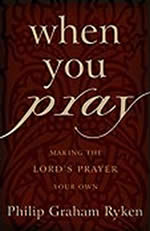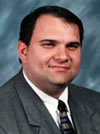Book Review—When You Pray
Reviewed by Frank Sansone.
Ryken, Philip Graham. When You Pray. Phillipsburg, PA: P & R Publishing, 2006 (originally published by Crossway Books, 2000). Paperback, 206 pages. $13.99.
(Review copy courtesy of P & R Publishing) Purchase: P & R | CBD | CVBBS | Amazon
Purchase: P & R | CBD | CVBBS | Amazon
Special Features: Includes bibliographical references and index. Discussion questions at the end of each chapter.
ISBNs: 1596380527 / 9781596380523
LCCN: BV230 .R95
DCN: 226.9606
Subjects: Prayer, The Lord’s Prayer
Philip Graham Ryken (B.A., Wheaton College, 1988; M.Div., Westminster Theological Seminary, 1992; and D. Phil., University of Oxford, 1995) is Senior Minister at Philadelphia’s historic Tenth Presbyterian Church. He has authored and co-authored several books including What Is the Christian Worldview (P&R Publishing, 2006); The Message of Salvation, The Bible Speaks Today (Leicester, UK/Downers Grove, IL: InterVarsity, 2001); The Doctrines of Grace: Rediscovering the Evangelical Gospel, with James Montgomery Boice (Wheaton, IL: Crossway, 2002); City on a Hill: Recovering the Biblical Pattern for the Church in the 21st Century (Chicago: Moody, 2003); and Ryken’s Bible Handbook, with Leland Ryken and Jim Wilhoit (Wheaton, IL: Tyndale, 2005). Just published is a work that both he and his father, Leland Ryken, edited, the ESV Literary Study Bible. SI’s Interview with Dr. Philip Graham Ryken (audio).
When Jesus’ disciples recognized their need to pray, they asked Jesus Christ to teach them to pray. The answer Jesus gave to their request is found for us in Matthew 6, a prayer commonly called “The Lord’s Prayer.” In When You Pray: Making the Lord’s Prayer Your Own, Dr. Philip Graham Ryken provides a helpful study of that prayer and encourages the reader to view “The Lord’s Prayer” not only as something to be recited but also as something to actually learn from. As Ryken correctly points out early in the book, “Jesus’ teaching about prayer begins with an urgent request: ‘Lord, teach us to pray’ (Luke 11:1). Not ‘teach us how to pray,’ notice, but ‘teach us to pray.’”(p. 13), and it is that desire to teach us to pray that seemed to direct Ryken as he wrote this book.
In the introductory chapters, Ryken discusses “How to Pray Like a Hypocrite” and “How to Pray Like an Orphan.” In these chapters, Ryken deals with verses in Matthew 6 that precede “The Lord’s Prayer” and encourages the reader to pray in secret and to avoid the error of praying repetitiously. As Ryken points out “the prayer babbled more than any other is probably the Lord’s Prayer. How ironic!” (p. 36).
In contrast to the first two chapters, chapter three shows us “How to Pray Like God’s Own Dear Child” and deals with the familial aspects of the prayer. This kind of prayer is directed to “Our Father,” suggesting not only a father-child relationship between God and the supplicant but also a brother-or-sister-in-Christ relationship between believers.
Ryken spends the rest of the book breaking down the prayer into 10 phrases, discussing each phrase in detail. Rather than dealing only with the academic details of these phrases, Ryken encourages the reader not only to understand what the passage teaches but also to do what it teaches.
As the subtitle of the book indicates, Ryken’s goal is not merely to explain the passage, but rather to encourage the reader to “Make the Lord’s Prayer Your Own.” The writing style bears this goal out, as it is a very readable book. In fact, it comes across as though this material was originally preached and then edited into book form. The book is also filled with personal comments and pastoral insights rather than a mere third-person academic accounting of “The Lord’s Prayer.” At one point, Dr. Ryken comments, “My goal as a minister is to keep the proclamation of God’s Word and the prayers of God’s people at the center of church life (see Acts 6:4). The great difficulty, however, is that this requires me to be a man of prayer as much as a preacher” (p. 13).
In addition to being a warmhearted exposition, the book manages to incorporate a presentation of the Gospel. At first, I thought this was odd, considering the fact that this is a book on prayer. But considering the interest in “The Lord’s Prayer,” even among those who do not attend Bible-preaching churches, I found this to be a wise addition.
Also, the book is set up in such a way as to make it useful for a home Bible study or an adult Sunday school class. It has discussion questions at the end of each chapter and is broken down into 13 lessons (to fit in nicely with the typical 13-week Sunday school quarter).
It may be worth mentioning that Ryken does not interpret the Scriptures from a dispensationalist viewpoint. This fact is most evident in chapter 6, which deals with the phrase “Your Kingdom Come.”
When it comes to the doxology, Dr. Ryken tries to walk a tightrope. He follows modern scholarship in stating, “On the basis of this somewhat contradictory evidence, it seems best to conclude that the traditional doxology possibly was not part of the original text of Matthew, but certainly was in use from the early days of the church” (pp. 174-175). However, he still provides some good material on the meaning of the doxology and comments that “it hardly seems right to consider the traditional ending of the Lord’s Prayer a mere trifle or a matter of taste, for it is a highly appropriate way for the prayer to end” (p. 175).
When You Pray is definitely a book worth adding to your library. For the serious layman, this book will help you to better understand this important passage of Scripture and will encourage you to get to the business of prayer. For the pastor, this book provides sound exegesis and pastoral insights that make it a very helpful book for preparing to preach on “The Lord’s Prayer.”
 Frank Sansone has served as pastor of Fellowship Baptist Church (Salisbury, MD) since December 2004. He also served as youth pastor and assistant pastor for 13 years in churches in North and South Carolina and New Jersey. He has traveled with an evangelistic team and preached in a number of churches, camps, and Christian schools. Frank enjoys spending his free time with his wife, Missy, and his three children; coaching his children in soccer; and writing on his blog. Frank Sansone has served as pastor of Fellowship Baptist Church (Salisbury, MD) since December 2004. He also served as youth pastor and assistant pastor for 13 years in churches in North and South Carolina and New Jersey. He has traveled with an evangelistic team and preached in a number of churches, camps, and Christian schools. Frank enjoys spending his free time with his wife, Missy, and his three children; coaching his children in soccer; and writing on his blog. |
- 20 views


Discussion